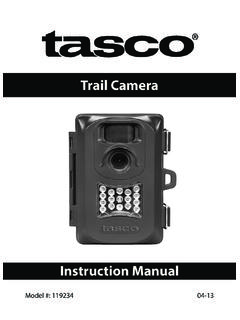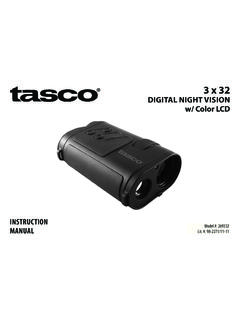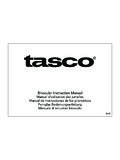Transcription of Tasco OffShore 6LIM
1 LIT. #: 9806050605 instruction manual manuel d instructions manual de instrucciones Bedienungsanleitung Manuale di istruzioni manual de instru es23 Index English ..4 Fran ais ..12 Espa ol ..20 Deutsch ..29 Italiano ..36 Portugu s ..444I. Basic Binocular AdjustmentsA. IPD AdjustmentSet the interpupillary distance by grasping the body and bending it until you can see a single circular image. The setting for your eyes will be indicated on the IPD scale. Note this scale setting for quicker resetting later. B. Focusing 1. Close your left eye, rotate the right eyepiece until the object appears sharp and clear. 2. Open your left eye, close right eye. Rotate left eyepiece until the object appears sharp and clear. 3. To focus on other objects, repeat Steps 1 and 2. 4. If you share your binocular with another person, note the diopter index mark settings at the base of the eyepieces fi rst.
2 Then you can simply return the eyepieces to those settings when you next use the binocular to view an object at the same Rubber Fold-Down EyecupsThese convenient eyecups fold down for use with eyeglasses and fold up for use without eyeglasses. They provide comfort and promote viewing ease. They will not scratch your glasses. IPD Scale (on hinge cap)Diopter Index Marks(both sides)5II. Using the Reticle and Dial to Determine Distance or SizeOffshore models 36 and 54 have two ranging tools. The eyepiece Reticle Scale and the Calculator Dial can be used to determine your distance from an object if its size is known, or vice versa. Please refer to the illustrated example on the next page as you read the following directions. When the object size is known, its distance is determined as follows:1. Look through your binocular and place the horizontal reticle line at the base of the object 2. Count the number of reticle divisions from the base to the top of the object.
3 (In the example on the next page, the top of the lighthouse comes to on the Reticle Scale)3. Rotate the Calculator Dial and place this number ( ) at the Angle Index Mark 4. Assuming you know that the height of the lighthouse is 100 ft., look to the right of the Angle Index Mark and find the object size on the scale labeled Object Size . In this example, use 10 .NOTE: The object size divisions are from 1 to 20. In dealing with an object that is 100 feet, mentally add a zero to the 10 indicator on the object size Now read the distance scale directly beneath the object size. It is 400 but remember, because you added a 0 to the 10 in Step 4, you must add a zero to the 400. Thus, the distance from you to the lighthouse is 4000 feet. IMPORTANT: Always remember that the Distance and Object Size scales are in a ratio to each other. When you add 0 s to one, you must add an equal number of 0 s to the other as we did in Steps 4 and 5 above. ENGLISH6 Object Size ScaleObject Distance ScaleAngle IndexReticle Angle Index ScaleBase to Top of Lighthouse= : Top of lighthouse is level with on reticle angle scale.
4 Rotate calculator dial so on angle index is opposite the mark. If lighthouse is known to be 100 high, distance to the lighthouse is 4000 . 7 When distance to the object is known, its size is determined as follows:1. Count the reticle divisions occupied by the object 2. Rotate the Calculator Dial, so that the Angle Index Mark points to the number from the reticle scale .3. Look at the Distance Scale, and fi nd your known distance to the object (for example, 4000 feet, or 400 on the scale). The number on the Object Size scale that is opposite this distance indicates the size of the object (for example, 100 feet). As mentioned previously, remember that the distance and size scales are ratios, be sure to add the same number of zeros to the numbers on both scales (10:400 / 100:4,000 / 1,000:40,000, etc)III. Using the CompassOffshore models 36 and 541 feature a built-in compass with illumination. The compass scale is refl exed into the eyepiece and can be seen while looking through the binocular.
5 Each scale division equals 1 of use the compass, hold the binocular in viewing position and focus on the object. While holding steady on the object, note the compass reading that appears beneath the fi xed central index line. The reading will indicate the magnetic direction to the object. For use at night, locate and focus on an object in the normal manner and when ready to determine azimuth, press the illuminator switch. The compass scale will be illuminated in red light for easy viewing, without affecting your night vision. Compass Scale as seen through right eyepiece ( 0 beneath index line indicates heading is due north)8 Detailed Operational Example: Navigation with The Compass and Rangefinding ScalesThe following examples use nautical situations to explain the use of the compass and Rangefinding scale features. However, the same principles apply to navigation on land. Please refer to the illustrated figures on the next page as you read the section below: Used by itself, a compass will only indicate direction to or from an object but not relative position.
6 To determine position, you need a map or chart and a protractor of some type. and 2 illustrate this point. In , the arrow shows your general direction of travel but not your course or position. shows that you have taken a compass reading from your boat to the buoy and that it is on a bearing of 190 . You now know your course is 190 , but you still do not know your position. To determine position, you should now lay in your course line FROM the buoy. Since your direction of travel is 190 , direction FROM the buoy will be 10 (this is known as back azimuth. Back azimuth is compass reading mi-nus 180 ). The next step is to take a bearing on a second fixed object. shows that the lighthouse lies on a bearing of 300 from your position. Laying in the back azimuth of 120 from the lighthouse, your position will be indicated by the intersection of the two lines. NOTE: the illustration does not take into account errors in compass readings due to the earth s magnetic field or errors induced by the effect of nearby metal objects.
7 The amount of correction required for errors due to the earth s magnetic field (know as variation) will be indicated on your charts. Local disturbances from metal objects, such as engines, fittings, etc. (known as deviation) should be determined from accurately known fixed positions. illustrates the use of the rangefinding reticle. You are on a known course of 180 and you know that when you are abeam of the lighthouse you should be 2 miles from it. The lighthouse is known to be 86 high, and a range reading shows that it occupies one division. Using the rangefinding calculations, you determine that you are miles east of the lighthouse. You now know that you are east of your intended course by of a mile. 91234 BuoyBuoyBuoyLighthouseLighthouseLighthou seLighthousePositionPosition10IV. Replacing the Compass Illuminator Batteries (OS 36/54)Batteries are included and pre-installed in your OffShore binocular. When it becomes necessary to replace them, unscrew the battery cover with a coin or screwdriver and replace the batteries with the same type, a pair of alkaline #186 / LR43 , or silver oxide #389 / SR54 batteries.
8 Be sure to install the batteries in the same direction as the originals, with the fl at positive (+) side facing up towards the cover on both batteries, and also check that the metal clip is over the positive (+) end of the top battery as shown. Screw the battery cover back on tightly and press the compass illuminator switch to test the light-a red glow should be visible around the compass (you may need to cover the right objective lens if you are outside in bright light). Battery CoverTripod Adapter SocketBattery CoverMetal ClipPositive (+) Facing UpMetal ClipFacing UpCompass Illuminator Switch11V. Tripod Mounting A threaded socket for tripod attachment is located at the base of the binocular hinge (see photo on previous page). Insert a binocular tripod adapter (Bushnell #161001CM or similar), and attach your tripod screw to the base of the How to Care for Your Binocular the lens covers (that come with your binocular) on the lenses when the binocular is not in use.
9 2. When wiping the lenses, use the lens cloth that comes with the binocular, or a soft, lintless cloth. 3. To remove any remaining dirt or smudges, add one or two drops of alcohol to the cloth and wipe Store your binocular in a moisture-free Should your binocular be exposed to salt water or salt laden humidity, it should be thoroughly rinsed in fresh : Never attempt to clean your binocular internally or take it apart. This will violate your warranty and compromise the waterproof/fogproof integrity of the ! Viewing the sun can cause permanent eye damage. Never look directly at the sun with your R glages de base des jumellesA. R glage de la distance interpupillaire (IPD) R glez la distance interpupillaire en tenant le corps et en le courbant pour faire appara tre une image circulaire unique. Le r glage pour vos yeux sera indiqu sur l chelle IPD. Prenez note de ce r glage pour pouvoir effectuer rapidement une remise z ro par la Mise au point 1. Fermez l oeil gauche, tournez l oculaire droit jusqu ce que l objet soit net (fi gure 2).
10 2. Ouvrez l oeil gauche, fermez l oeil droit. Tournez l oculaire gauche jusqu ce que l objet soit Pour une mise au point sur d autres objets, r p tez les tapes 1 et Si vous partagez vos jumelles avec quelqu un d autre, notez d abord les r glages de l chelle diop-trique la base des oculaires. Ensuite, vous pourrez simplement utiliser ces r glages sur les oculai-res la prochaine fois que vous utiliserez les jumelles pour observer un objet la m me illetons en caoutchouc rabattablesCes oeilletons commodes se rabattent vers le bas s ils sont utilis s avec des lunettes et se rel vent si utilis s sans lunettes. Ils vous procurent confort et commodit d observation. Ils ne rayent pas vos lunettes. chelle IPD (sur le chapeau de charni re)Rep res d index diop-trique (des deux c t s)13II. Utilisation du r ticule et du cadran pour d terminer la distance ou la tailleLes mod les OffShore 36 et 54 disposent de deux outils t l m triques. L chelle du r ticule de l oculaire et le cadran du calculateur peuvent tre utilis s pour d terminer la distance qui vous s -pare d un objet si sa taille est connue ou vice versa.







